No telescope? No problem. Just use your eyeballs! On a dark summer night at least two dozen deep-sky objects can be seen without optical aid.
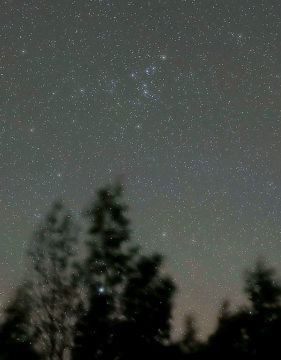
Bob King
If you'd asked me a year ago how many deep-sky objects I'd viewed with the naked eye, I would have said maybe 15. Deep-sky objects (DSOs), which include star clusters, bright and dark nebulae, and galaxies, are among the favorite targets of first-time and long-time telescope and binocular users. They all lie beyond the solar system and most have a measurable size and shape, unlike double stars, which remain points of light even at high magnification.
From antiquity through the early Middle Ages, astronomers recorded about a dozen DSOs: the Pleiades (M45); Hyades; Double Cluster — NGCs 869 and 884; Beehive Cluster (M44); M7; Coma Berenices Star Cluster (Melotte 111); Andromeda Galaxy (M31); the two Magellanic Clouds; the southern open cluster IC 2391; and possibly M41.
Allowing for latitude, all of these objects are visible from moderately dark skies with the exception of the open cluster M41 in Canis Major, which requires an extra dose of dark.
One of the joys of writing for Sky & Telescope is getting to know other amateur astronomers and their favorite things to see. A while back, Scott Harrington, an amateur from Evening Shade, Arkansas, wrote to me about his project to see as many deep-sky objects as possible with just the naked eye and 7×35 binoculars. He's now found about 90 DSOs without optical aid, including such hard nuts as the Dumbbell Nebula and M92.
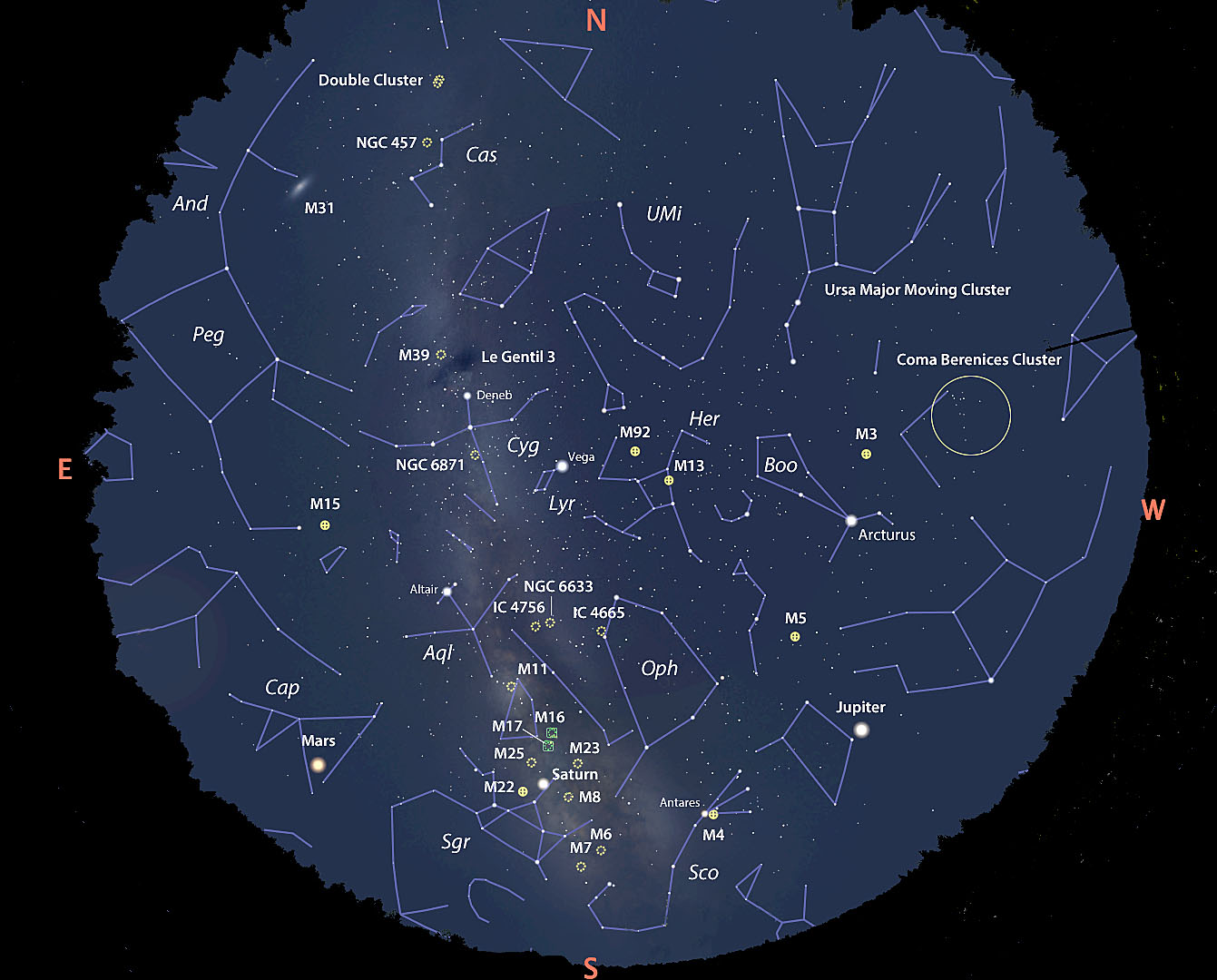
Stellarium
I'd seen M42, M13, M5, M6, and a few others missed or unrecorded by ancient eyes, but after a few e-mail exchanges with Scott, I wanted to push the envelope. And what better season than summer, with the Milky Way exploding over the southern and eastern horizons?
So I spent several pleasant evenings sans telescope with Ptolemy in my thoughts and a map at the ready looking for tiny patches of fuzz. With a little effort and frequent use of averted vision — the technique of looking around a faint sky object rather than staring directly at it — I managed to identify 23 deep-sky objects in the June sky alone.
These included open clusters, globulars, bright and dark nebulae, and one galaxy. The more I challenged myself, the more I found. A few eluded me, like the Dumbbell and M81, but I was surprised by how many I could see.
Strangely enough, seeking them reminded me of looking for faint galaxies in a big telescope except I became the telescope, making the venture something of an out-of-body experience.
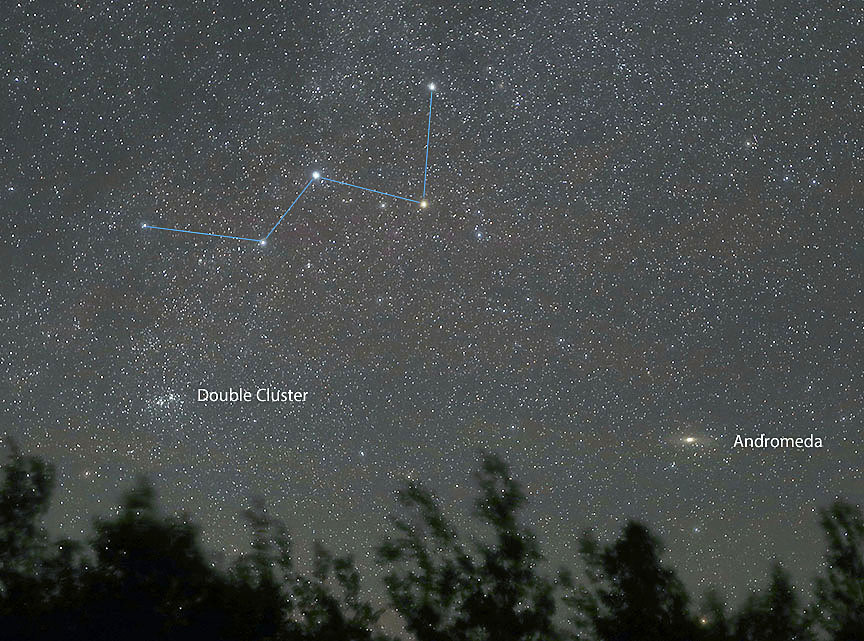
Bob King
Most of my observations were made under rural Bortle Class 3 skies with a limiting magnitude of around 6.6 under a richly textured Milky Way with only modest light pollution to the south. Later, I confirmed many of the objects at my home under more compromised Class 4 or rural/suburban transition skies with a limiting magnitude of 6.1.
I stayed up past midnight to view two of the brightest and easiest objects, M31 (Andromeda Galaxy) and the Perseus Double Cluster. Otherwise everything was well placed for viewing before midnight. My only tools were a red flashlight, a handy star atlas (I used the S&T Pocket Star Atlas), and a pair of 10×50 binoculars to confirm the position of each DSO. Sweet freedom — no scope to pack!
Level 1: Easy Pickins
We don't usually think of it as a deep-sky object, but the Ursa Major Moving Cluster, comprised of all the Big Dipper stars except for Alkaid and Dubhe and a smattering of fainter members, is a loosely-bound cluster or stellar association located about 80 light-years distant, making it one of the closest star groups in the sky.
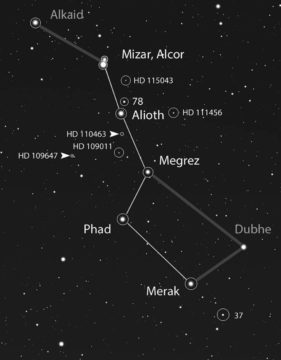
Stellarium with additions by the author
Not to be outdone, the nearby Coma Berenices Cluster offers up a dozen or more stars in a lazy V some three outstretched fists below the Dipper's handle. It lacks the luster of the Ursa Major Group, but being slightly more compact (7.5° across) and richer in naked-eye stars (most are magnitude 4.5 and fainter), it more resembles a typical star cluster. Coma also goes by Melotte 111 and lies 280 light-years from Earth.
The Andromeda Galaxy is one of the largest of the naked-eye DSOs at several degrees across. Even when its only 20° high I can make out its oval shape with direct vision and its extended, brighter nuclear region with averted. At 2.5 million light-years, Andromeda is one of the most remote objects visible with the naked eye.
Cassiopeia makes its way into the northeastern sky on summer nights, toting along NGC 457, AKA the Owl or ET Cluster, with its bright luminary Phi (φ) Cas. I could see 5th-magnitude Phi but even a heavy dose of averted vision wasn't enough to root out the cluster. When it's near the zenith later this fall, I'll give it another go. With a magnitude of 6.4 it would seem a possibility.
Below Cassiopeia's W I easily discerned the Double Cluster as an extended object with direct vision and as two separate but touching puffs of light by scanning around it. NGC 869 appeared a tad brighter than its neighbor NGC 884.
Finally, the large, starless gash in the Milky Way centered 8° north of Deneb in Cygnus remains one of the easiest of the dark nebulae to behold on a good night. Named Le Gentil 3 or the Funnel Nebula, it's about 5° long and narrows from west to east.
Level 2: Eyeball Exercisers
The Sagittarius portion of the Milky Way suffers from atmospheric extinction at my latitude of 47°N. That's why several objects in this category will be easier to spot if you live in the southern United States and points south. One of those is M7, a big, bright open cluster close to the Stinger Star in the tail of Scorpius. Pity it stands only 9° high at best from my home. I had to work a little to see the magnitude-3.3 cluster, but with averted vision I clearly made out a big, diffuse patch more than a degree across. I can only imagine how obvious it must look from the tropics. Still, an amazing sight and one of my favorites.
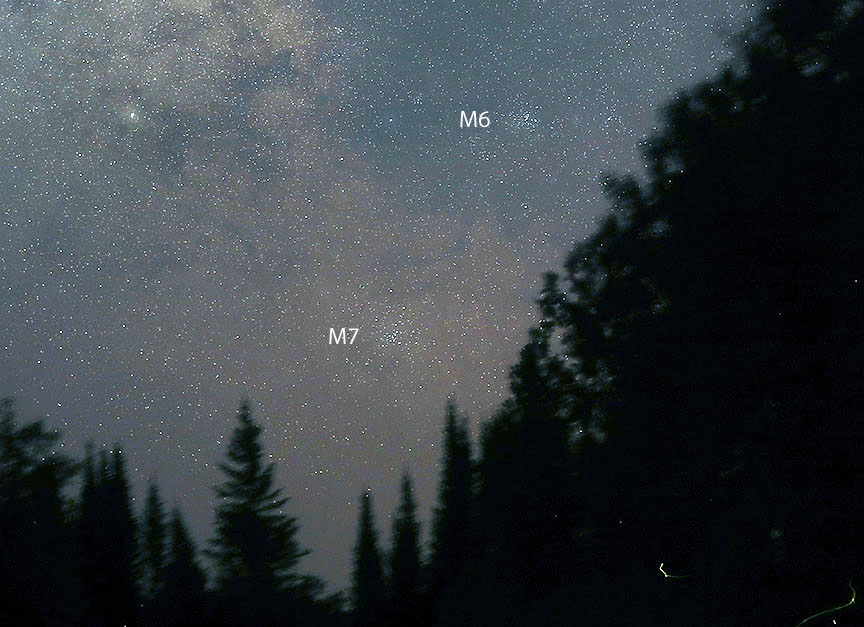
Bob King
Once you've found M7, muster the courage and go for M6 (magnitude 4.2, 25′ across) situated a bit shy of 4° northwest of M7. This open cluster, nicknamed the Butterfly, appeared quite faint, but with repeated effort I could at least see a weak smudge of extended haze at the location.
If we now head east and north into Sagittarius, we'll fine one of the finest naked-eye, deep-sky fuzzies — the Lagoon Nebula (M8). This open cluster–nebula combo is unmistakable even in Bortle Class 4 skies. I immediately saw a blob of nebulosity extended east–west that stood apart from the more diffuse Milky Way clouds in the region. There's a bonus here, too. The stars 9 Sagittarii (magnitude 5.9) and 7 Sagittarii (magnitude 5.3) twinkle into view on either side of the nebula with averted vision, offering a miniature version of the telescopic view. A most pleasing view.
Feeling my confidence I next tried for M20, the Trifid Nebula. But though several faint stars and a hint of haze were glimpsed at its location, I couldn't confirm seeing the nebula.
Then it was time to hop over to the other side of the Teapot for a look at the globular M22. I was amazed at how easy it was to see with averted vision; the cluster appeared as small, round cloud. In hindsight I shouldn't have been surprised given its magnitude of 5.1 and 1/2° diameter.
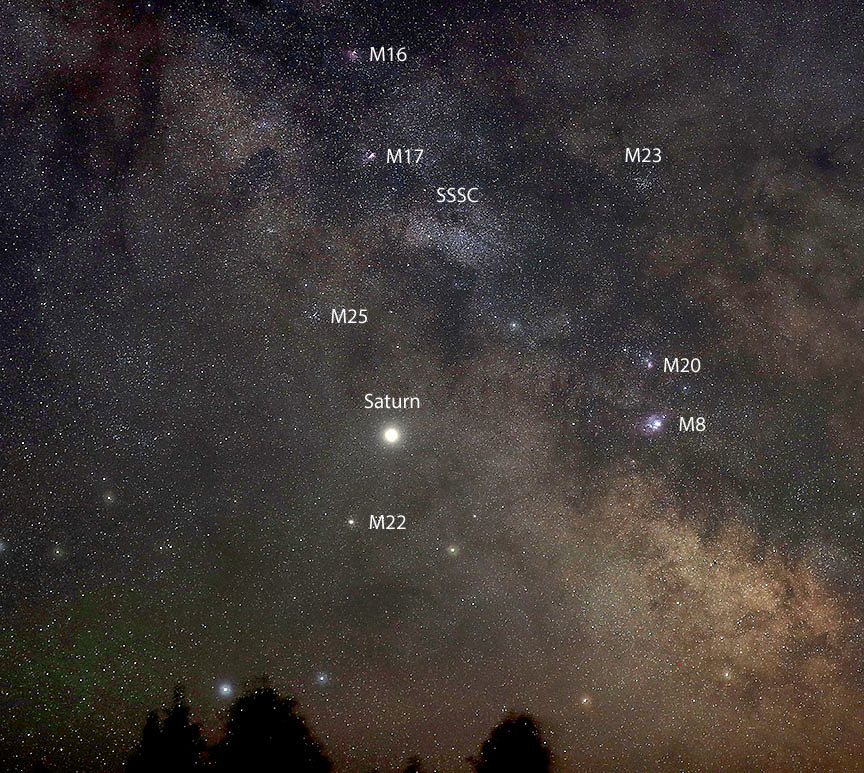
Bob King
When seeking fainter objects I employ the same technique I do at the telescope when hunting for a faint comet or galaxy: Make a triangle or a box with the available bright stars and connect them to the position of the sought-after DSO. For M22 I used Saturn and Lambda (λ) Sagittarii to form a triangle with the cluster. Worked like a charm.
The bright open cluster M25 lies 5° north of M22 and ½° south of a 5th-magnitude star. I found it fairly easy to pick out with averted vision — like so many of these objects, it looked like a dim ball of haze, a little more spread out and diffuse compared to M22. M25 shines at magnitude 4.6 with an apparent diameter of 32′.
Next, we tip our gaze into the darker pastures of northern Ophiuchus, where I easily flushed the open cluster IC 4665 located 1.3° northeast of Beta (β) Ophiuchi. It's close to a naked-eye star, which helped me figure out exactly where to look. At magnitude 4.2 and 45′ in diameter, it appeared as a discrete, milky blob just above the star when I looked at it using averted vision .
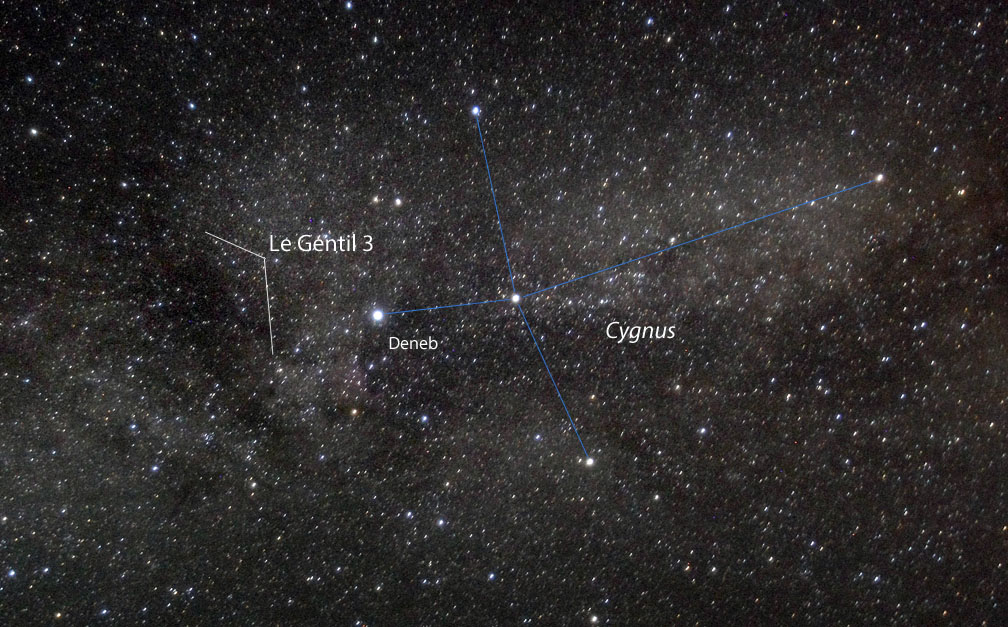
Bob King
Far over to the east in Cygnus, I set my sights on the 5.5-magnitude open cluster M39, which forms a parallelogram with three nearby 4th-magnitude stars. Once I pinpointed the location with their help, the cluster appeared as a round, fuzzy spot and offered an unexpected surprise: I could discern two or three faint member stars within the haze.
We wrap up our Level 2 group with the Great Hercules Globular or M13, located high in the southern sky at nightfall in early July. Thanks to its altitude, the cluster occupies the darkest part of the sky, making it even easier to spot than M22 despite its fainter magnitude of 5.8. A quick look shows a faint "star" at the position, but averted vision reveals an extended haze around it. M13 is about 20′ across.
Level 3: Might Hurt A Little
At magnitude 6.6, the globular cluster M5 in Serpens is by no means easy. It helps that it lies just 20′ northwest of 5th-magnitude 5 Serpentis. I still had to play averted-vision hardball to see it. After repeated tries, a faint dab of mist materialized into view above the star. The two are so close together that the cluster looked like a short "comet tail" with 5 Serpentis as the "head." Never mind that it took some eyebrow grease to find M5. You'll be captivated seeing something 24,500 light-years away with nothing more than squishy optics.
I next returned to the magnificent array of clusters and nebulae above the Sagittarius Teapot. Saturn and the bright Small Sagittarius Star Cloud were my waymarks to M17, the Swan Nebula, and M16, the Eagle. Both were faint, small puffs of "fog" seen only with averted vision. M16 appeared a little larger than M17. Both glow at magnitude 6 from 7,000 and 5,000 light-years away, respectively.
Further up in Ophiuchus–Serpens I ferreted out neighbor clusters IC 4756 and NGC 6633. The first shines at magnitude 4.6 with a diameter of 40′. Though faint, I could make out an extended, diffuse haze elongated east–west. About 3° to the northwest, NGC 6633 was a soft glow immediately north of a 5.7-magnitude star and easy to see with averted vision. To be honest, I should have included this one in Level 2. I got a thrill seeing these two clusters and neighboring IC 4665 simultaneously. Who knew so much cool naked-eye stuff was happening here?
Level 4: Agony and Ecstasy
While other deep-sky objects above the Teapot took some effort to see, the open cluster M23, magnitude 6.9 and 27′ in diameter, took all the eye power I could muster. It finally appeared as a very faint, diffuse patch after repeated attempts. To help in finding it, I used the asteroid Vesta, which happened to be nearby at the time.
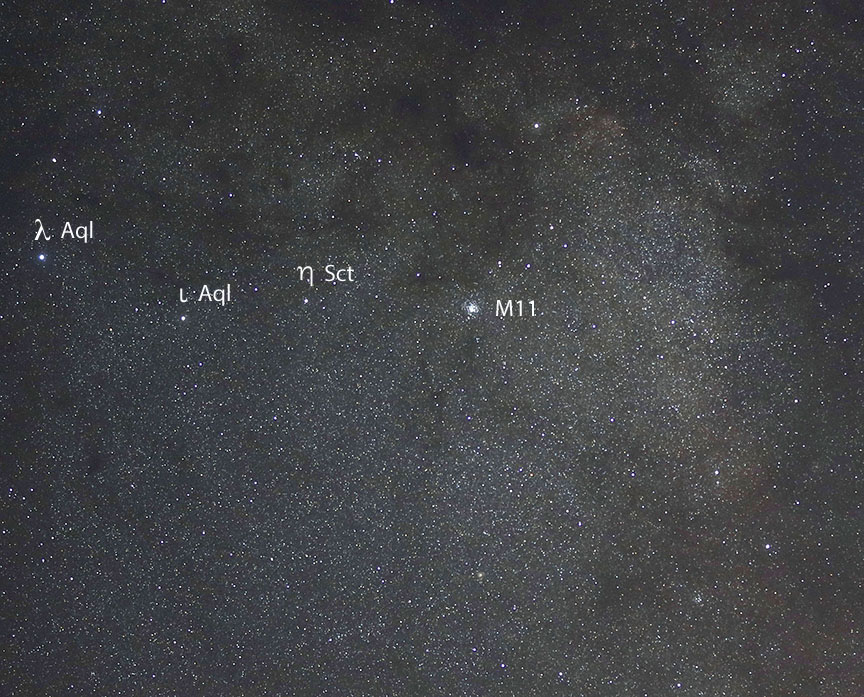
Bob King
The Wild Duck Cluster M11 proved equally difficult but for a different reason. Although compact and relatively bright at magnitude 6.3, it sits within the bright Scutum Star Cloud at the end of Aquila's tail. The lack of contrast is a challenge, but I persisted with askance vision and finally confirmed the cluster as a small, dense dot of light that came and went with the roll of my eyes.
The globular cluster M15 in Pegasus was even more difficult. Although it shines at magnitude 6.2, I only saw the faintest smudge on several occasions. M92 was a tad easier if only because it was at the zenith. Although very faint, it was a tiny, non-stellar patch with averted vision.
Objects I tried to see but was unsuccessful included NGC 6271 and M29 (open clusters in Cygnus) and the globulars M4 in Scorpius and M3 in Canes Venatici. Since you might have better luck or skills, I included them on the big map. Below are links to high quality finder maps from the Pocket Star Atlas. Circled stars on these maps make useful guides. Click, save, and print:
- M5
- M13, 92
- Ophiuchus / Serpens DSOs
- Sagittarius / Scorpius DSOs
- M39 and Le Gentil 3
- Scott Harrington's 250+ DSOs Visible with 7×35 Binoculars and the Naked Eye
Let your eyes become your telescope the next dark, moonless night.
 19
19
Comments
hwb3
June 27, 2018 at 12:52 pm
2.5 million ly
You must be logged in to post a comment.
Bob KingPost Author
June 27, 2018 at 3:25 pm
hwb3,
Of course! Thank you 🙂
You must be logged in to post a comment.
PGT
June 27, 2018 at 1:29 pm
Great article and great idea!
I don't get out of the city much these days, but I still remember the first time I saw the Andromeda Galaxy and realized that the light from it was older than any modern human!
You must be logged in to post a comment.
Bob KingPost Author
June 27, 2018 at 3:25 pm
Paul,
I hope you get to see some of these. Some of the clusters, while not at Andromeda distances, are incredibly far away for a single object.
You must be logged in to post a comment.
Joe Stieber
June 28, 2018 at 3:56 pm
Another fine article Bob!
I've always been fond of observing with unaided eyes, and I've seen many of the items you mention here. I'll take a stab at the ones I haven't seen yet; however, I think my eyesight is declining with my advancing age (I'll be 69 soon). Lately, I haven't been able to see M13 with unaided eyes as easily as I used to see it, and I wasn't able to spot Vesta without doubt this month before the moon interfered. I'd like to think my Vesta failure was mostly due to it's low altitude, but maybe not. Regardless, I still like to look at the sky sans optical aid (and binocular viewing is also wonderful).
BTW, I couldn't find any mention of the Coathanger in Vulpecula (Collinder 399) in your article. Was it disqualified because it's no longer considered a true star cluster? It certainly remains a cluster in the visual sense.
You must be logged in to post a comment.
Bob KingPost Author
June 28, 2018 at 4:56 pm
Hi Joe,
Yes, as much as I wanted to include the Coathanger I had to hang it up because it's no longer considered a true star cluster. Good luck on spotting the others! I'm also working on a fall-winter series of deep-sky objects.
You must be logged in to post a comment.
Walter Clayton
June 29, 2018 at 9:22 am
Hey Bob!
I was hoping you would have mentioned M33 in the list. I am guessing that it just was too far East for your article
I did a lot of naked-eye astronomy when I was a child and didn't have a scope. I lived in the middle of Savannah Ga and, back then, could see the Summer Milky Way easily, even after they build the hospital the next block over. Could see Mel 111 and Andromeda too.
Now, I am getting 'older person eyes' it's harder to do, but, I can still pick up some items in town (I live on the outer fringes of Savannah now), and have found the Milky Way again.
Le Gentil 3: I didn't know this area had a name. I first noticed it the night of August 29th 1975 when Nova Cygni 1975 went off. I and the guys in my club were out early enough to see it (our Observing Chair was the 4th person to report it in America...couldn't find a phone fast enough), and we pulled an all nighter. Le Gentil 3 was just below the nova.
M33: Just a few months later, we went to a friends farm inland. It was about 20 deg that night and VERY dry. M33 stood out like a icy blue sore thumb.
Now, I am getting ready to retire, and we are going cruising on our sail boat. I told the captain the first thing I want to do is to go out 80 or so miles, beyond the gulf stream, and see "dark". I'll be keeping this article in mind!
Thanks!
Walter Clayton
Savannah, GA
You must be logged in to post a comment.
Bob KingPost Author
June 29, 2018 at 2:21 pm
Hi Walter,
You guessed right. I didn't include M33 because it rises so late. I do plan on a second fall-winter installment, so stay tuned! Make a set of copies of the maps you can bring with you when you're bobbing up and down in the Gulf Stream under star-studded skies. And let us know how many more you're able to find. You mentioned Nova Cyg 1975 -- that was the last truly bright nova I've seen. We're due!
You must be logged in to post a comment.
Anthony Barreiro
June 29, 2018 at 1:56 pm
Thanks very much, Bob. I'll take this list with me when I get out of town later this summer.
By the way, I think you saw *two* galaxies ... . 😉
You must be logged in to post a comment.
Bob KingPost Author
June 29, 2018 at 2:17 pm
Anthony,
Right you are my friend! How could I overlook our home?
You must be logged in to post a comment.
SNH
June 29, 2018 at 5:58 pm
Nice article, Bob. I'm really surprised that you had seen so few DSO naked-eye before this! Though I've seen 42 Messier objects naked-eye (which I believe is second only to O'Meara's 47), I've not been able to see M29 naked-eye either. Glad to hear that you tried it though. Maybe my rating system in the 250+ Catalog PDF will be useful to you - you've now seen M92 overhead which I find is the same brightness as M36 overhead! Go for it!
M5 is not easy for me either (though I'm 11 degrees farther south then you) since it sits only 20' from a +5.1 star. That's why I've found M3 to be the same easy of visibility even though its fainter since it sits 30' from a +6.4 star! Funny how that works. M4 has always bothered me because its barely visible to me, even on the best of nights, due to its diffuseness! Glad you tried for it, but only southern observers get to really enjoy it naked-eye.
I've tried for NGC 457, but like several "naked-eye" open clusters that I know of, only its brightest member is visible - with no hint of the others around it naked-eye. So I don't include those on my list because there is no sighting of the "cluster" to me! Glad to see you mentioned the distance factor for M5. I love seeing M2 naked-eye because its 37,500 light-years away! That's extremely far for naked-eye, though not as far as 11 million for my M81 sighting...
I've currently seen, naked-eye:
2 planetary nebula,
4 galaxies,
4 bright nebula,
12 globular clusters,
24 dark nebula,
and 61 open clusters, not to mention a smattering of OB associations.
Really glad for your article, Bob. I don't want the fame, just happy to know that someone might find my list and be inspired to view stuff naked-eye! Glad you got inspired!
Scott N. Harrington
You must be logged in to post a comment.
Bob KingPost Author
June 30, 2018 at 10:37 am
Thanks Scott! I hope others will be inspired to look for these and more. Makes for great fun and lots of pleasant surprises for sure.
You must be logged in to post a comment.
astromaster
June 30, 2018 at 2:56 pm
Greetings Bob and Scott: You guys are doing a great job! I have just published a new book on the topic of Bright and Dark Nebulae 2017 CreateSpace and thought I would make some mention about Le Gentil 3. the professional designation is Lynds Dark Nebula ID # 234 which is also connected to Lynds Dark Nebula ID #s 220, 221, 223 and 239 which extends north toward Cepheus where it connects with Lynds Dark Nebula ID # 300 which extends all the way to Polaris where it then joins with other Lynds Dark Nebula ID #s 283 and 399 that extend into Cassiopeia. Be aware that when Dr. Lynds created her catalog she made two columns: one for each Lynds Dark Nebula and a second for her ID #s to show where some of her individual dark nebulae were gravitationally connected and she listed these objects in a second column as ID #s and these are best used for Naked Eye objects. Another example of such an object is Lynds Dark Nebula ID # 141 in the southern Hercules Milky Way just opposite from the bright star Altair and easily seen on any wide field photos of the Milky Way such as the new Gaia Catalog view.
You must be logged in to post a comment.
Bob KingPost Author
June 30, 2018 at 3:54 pm
Hey astro,
Congrats on the new book. I'll have to check it out. We appreciate the additional information on Le Gentil 3 — thank you! It's easy to get lost in the maze of dark nebulae threading Cygnus and Cepheus. Many find observing opportunities there.
You must be logged in to post a comment.
Bob
June 30, 2018 at 9:57 pm
Bob...
Great article.
Question: What is the farthest star that can be seen with the naked eye?
Bob
Kentucky
You must be logged in to post a comment.
Bob KingPost Author
July 1, 2018 at 1:28 pm
Hi Bob-P,
Oooh, good question. It's a bit up in the air. You'll often see V372 Cas mentioned (mag. 5.8, distance 16,000 ly), but apparently the data from the Hipparcos satellite is off on that one. We should get a better idea from the Gaia Mission soon. Mu Cephei, the Garnet Star (~mag. 5) is about 5,000 ly from Earth and Rho Cas is about 8,000. They are certainly some of the most distant naked eye stars.
You must be logged in to post a comment.
Bob
July 7, 2018 at 6:01 am
Thank you.
You must be logged in to post a comment.
ellenpa2000
July 18, 2018 at 12:40 pm
Wow, I love your article Bob! It inspired me to try this together with binoculars. With the KW-RASC I had the pleasure to visit the Algonquin Radio telescope last weekend. What a treat!
As it is far away from light pollution, we brought telescopes and I had my binoculars and... My eyes. It was so dark, the clouds were black against the starry sky. Some thunderstorms were going around far away but our sky was crisp with some clouds whipping by. So.... I saw M4!! Of course periferally but it definitely was there. I am so amazed what we can see. Your article certainly inspired me and if the mosquitoes wouldn't have been so bad (despite three layers of spray and cream they thought I was their main course, over 100 bites) I would have tried the whole list. Thank you so much for the article.
You must be logged in to post a comment.
Bob KingPost Author
July 19, 2018 at 6:28 pm
Hi Ellen,
I am so happy to hear you enjoyed the article and impressed you spotted M4. It's not easy that's for sure - definitely an averted vision object. Isn't it fun to discover the power of your eyes?
You must be logged in to post a comment.
You must be logged in to post a comment.